Wine is always better with a story—ideally directly from the source.
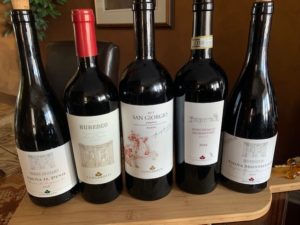 While that’s obviously best done in person (a wine never seems to taste better than it did at the winery), it also works on Zoom.
While that’s obviously best done in person (a wine never seems to taste better than it did at the winery), it also works on Zoom.
I was lucky enough to be part of one of those long-distance tastings last month when Profile Wine Group set up a sampling of five superb bottles from Lungarotti in Torgiano, Italy. If you were to draw a target around all of Italy, Torgiano would be the bullseye—in the heart of Umbria, flanked by the historic towns of Perugia and Assisi.
Joining our little group from 7,000 kms away was one of the winery’s principals, Teresa Severini, daughter of Maria Grazia (wife of the winery’s founder, Giorgio Lungarotti). Teresa’s sister, Chiaro Lungarotti, serves as CEO, while Teresa’s son Francesco looks after exports.
Today, Teresa concentrates on communications and marketing, but her résumé bears further noting. One of Italy’s first female oenologists/winemakers, she was also the first woman to be admitted to the prestigious Académie International du Vin in Geneva.
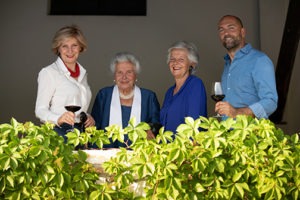
Chiara Lungarotti, Maria Grazia Lungarotti, and Teresa and Francesco Severini.
As for Ms. Grazia, well, the 95-year-young family matriarch is still going strong, Teresa notes. “She still goes to the office every day, working on the Lungarotti Foundation and our wine and olive oil museums.”
The Lungarotti winery has embedded itself with local history. Its foundation promotes cultural activities such as exhibitions, conferences and publications about the Italian agricultural economy, while the two outstanding museums trace the past 5,000 years of wine and olive oil significance in the Mediterranean region.
“The first use of olive oil was for lighting, not for food!” Teresa reminds.
FAMILY HISTORY
Expectedly, the family’s own viticultural roots also run deep in Umbria. As early as the 1700s, the Lungarottis produced wine and oil in the Middle Tiber valley. By the early 1900s, Giorgio’s father and uncle had become renowned for the quality of the wines they produced and marketed, including a famous vin santo (mass wine).
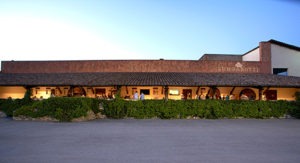
Guests enjoy a tasting at Lungarotti’s Torgiano winery.
By the time the Lungarotti Winery was founded in 1962, Giorgio was already making waves in Umbria. Wine author Hugh Johnson “said Giorgio put Umbria on the international wine map,” Teresa observes.
A towering man, Giorgio, who passed away in 1999, visited wineries in France and Germany to seek out new ways of growing grapes and producing wines in his native Umbria. He was among the first to introduce Cabernet Sauvignon, Merlot and Chardonnay to the area—sacrilege to many Italian winemakers—and was also the first to introduce the “green harvest” technique of winemaking to the region, whereby younger, more immature grape bunches are removed from vines to decrease their overall yield, allowing the plant to feed its energy and nutrients to the remaining grapes.
“People thought we were crazy,” Teresa says. “But then they started to appreciate the quality (of what was remaining on the plant).”
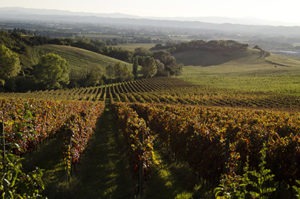 Giorgio’s efforts and expertise helped bring about the vaunted DOC and DOCG designations to the region for his class of wines. (A quick background of Italian wine designations: DOC (Designation of Controlled Origin) is the second-highest tier of wine production standards in Italy. It specifies the production area and methods for each wine, as well as a government-certified quality level. DOCG, meanwhile, is the top of the pyramid. The “G” essentially stands for a guarantee that these wines have passed a quality taste test from an expert panel.)
Giorgio’s efforts and expertise helped bring about the vaunted DOC and DOCG designations to the region for his class of wines. (A quick background of Italian wine designations: DOC (Designation of Controlled Origin) is the second-highest tier of wine production standards in Italy. It specifies the production area and methods for each wine, as well as a government-certified quality level. DOCG, meanwhile, is the top of the pyramid. The “G” essentially stands for a guarantee that these wines have passed a quality taste test from an expert panel.)
BUILDING THE BRAND
Giorgio’s marriage to Maria Grazia proved a perfect pairing for the Lungarotti family, but for the brand as well. “My mother helped introduce the cultural side of the enterprise,” Teresa says. “Together they not only created a great winery and vineyards, but something unique—something with tourism, hospitality and the culture of wine. We think understanding that culture is necessary to appreciate the wine.”
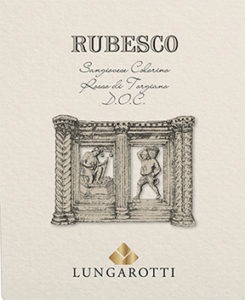 It’s evident in their labels. The hugely popular Rubesco, for example, depicts a harvest scene from one of the bas-reliefs of the Fontana Maggiore in Perugia, a famed 13th-century fountain designed by Nicola and Giovanni Pisano. And Lungarotti’s Montefalco Sagrantino red features a falcon in the foreground of the winery, a nod to Emperor Frederick II of Swabia, who loved practice falconry here 800 years ago.
It’s evident in their labels. The hugely popular Rubesco, for example, depicts a harvest scene from one of the bas-reliefs of the Fontana Maggiore in Perugia, a famed 13th-century fountain designed by Nicola and Giovanni Pisano. And Lungarotti’s Montefalco Sagrantino red features a falcon in the foreground of the winery, a nod to Emperor Frederick II of Swabia, who loved practice falconry here 800 years ago.
In more recent years, as with most wineries the world over, climate change has impacted Lungarotti. “We moved toward higher-alcohol wines because of the warming climate,” Teresa says. They also created an experimental vineyard 20 years ago to explore new varieties and different grape clones. That included the introduction of the Sauvignon Blanc-like Vermentino grape to their portfolio. Lungarotti also began a relationship in 2013 with the University of Perugia, becoming the leading member in a climate-data-sharing MeteoWine project.
Today, Lungarotti splits its production between two wineries. The bigger of the two, at 230 hectares, is in Torgiano at the confluence of two rivers, which provides it a warm microclimate. Its VIVA certification means no chemicals and serious attention to sustainability and preserving the soil. The second winery, a half-hour drive southeast in Montefalco, is a smaller, fully organically certified 20 hectares. Situated at a slightly higher altitude, its vines are swept by cool winds.
Incidentally, as part of lowering their environmental impact, Lungarotti made the recent move of adopting lighter glass bottles—a notable drop from 650 grams to 420 grams in its flagship wines.
The two wineries now produce a total of 29 different labels, with an average of about 2.5 million bottles a year—all under the watchful coordination of oenologist Vincenzo Pepe and agronomist Attilio Persia, assisted by consulting oenologist Lorenzo Landi.
Here’s a quick glance at our tastings, and how you can get your hands on them. Give Profile Wine Group a call for he bottles not available in the LCBO.
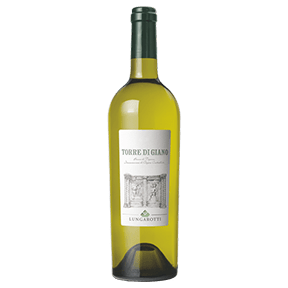 Lungarotti Torre di Giano Vigna il Pino 2018 — Umbria, Italy
Lungarotti Torre di Giano Vigna il Pino 2018 — Umbria, Italy
A tower dedicated to the Roman god Janus in nearby Perugia gives this wine its name, while “Vigna il Pino” represents a single vineyard with a big pine in the middle, where this wine is sourced.
It’s a combination of Trebbiano, Vermentino and Grechetto. Yellow gold in colour, this is a midweight, velvety-textured white, but one that also boasts great food-pairing ability due to its acidity. A very cautious amount of wood aging has helped keep it in harmony. Pear, apple, pineapple—maybe even a little honeydew on the nose. I love the way Profile Wine Group’s Drew Walker referred to it as having a “very precise verve with depth, but not to the point of being oily.”
Says Teresa Severini: “When I speak to people about the wines that represent us, this is the white wine I talk about.” 90
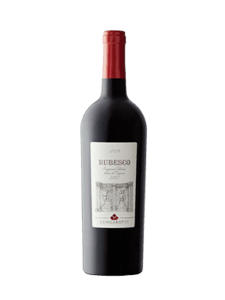 Lungarotti Rubesco 2019 — Umbria, Italy ($19.95)
Lungarotti Rubesco 2019 — Umbria, Italy ($19.95)
The name Rubesco, incidentally, was conjured by Maria Grazia some 60 years ago. From the Latin verb rubescere (to blush with joy), it was conceived to create a specific brand name for this special wine, which drew its quality from a new way to grow its vines and a scientific method of selecting the traditional varietals that went into it.
A blend of Sangiovese and Colorino, this is a medium-bodied red with medium tannins and vivacious acidity. Over the years it has inched up from 11% to 14% alcohol, but that alcohol is nicely baked into the recipe. It’s a deep ruby red in colour, fresh on the palate with solid structure and concentration. It offers a mesh of dark red fruit to the nose with a slight peppery oak spice (although the wood evidence is fairly subtle, thanks to no more than a year of aging in large second-use casks).
“I’m very grateful to this wine,” says Teresa of the Rubesco, which has been instrumental in building the Lungarotti brand and remains popular on restaurant wine lists throughout Ontario. You can sip this on its own or pair six ways from Sunday (16C recommended). Very good for the money and available at the LCBO. 89
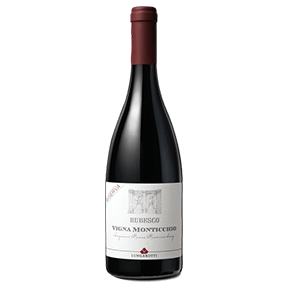 Lungarotti Vigna Monticchio Riserva Rubesco 2017 — Umbria, Italy ($69.95)
Lungarotti Vigna Monticchio Riserva Rubesco 2017 — Umbria, Italy ($69.95)
Rubesco’s big brother. “My stepfather was so fond of Burgundy that he decided this had to go in a Burgundy (pinot noir style) bottle,” Teresa says. This is 100% Sangiovese from low-yielding, high-quality vines. Last year, the 2016 vintage tied with the famed Bolgheri Sassacaia for top spot on Italy’s Top 100 Wines list in Gentleman magazine, part of the Milano Finanza Group, with scores calculated using the total ratings of all the major Italian wine guides.
Medium+ in tannins and body, has been aged in a combination of large casks and smaller barriques for no more than a year, before benefitting from further bottle maturation. It’s Barolo-ish in its depth and grip, without the tar. Look for spearmint, balsamic and violet overtones to the ripe blackberry fruit. It’s alive and ready to party now, but a few years of further rest will make it more elegant still. (And there’s decades of age-ability if you want.) 14% alc. 93
 Lungarotti San Giorgio 2017 — Umbria, Italy
Lungarotti San Giorgio 2017 — Umbria, Italy
Aged 12 months in barriques with an extra year in the bottle, here’s another wine with serious aging potential. The label bears the signature of Giorgio Lungarotti, who passionately experimented with this 50/50 blend of Sangiovese and Cabernet Sauvignon before creating the first “Super-Umbrian” in 1977. On the label there’s a depiction of Rafael’s famous painting of Saint George on horseback, slaying the dragon. The label is a tribute to the traditional Saint George feast, celebrated every April 23 with nighttime bonfires in the vineyards around Torgiano. There’s cassis to the nose and a powerful dark fruit blend of plums and blackberry jam, the concentration of which you could guess from the intense colour. The cabernet content is not overpowering, allowing the Sangiovese to control the show. But it still seems quite young, and while it will evolve as you progress through the glass (and the bottle), decanting is highly recommended. Or better still, lay it down for five years and revisit. 14% alc. 91
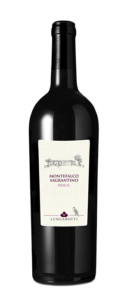 Lungarotti Montefalco Sagrantino 2018 — Umbria, Italy ($52)
Lungarotti Montefalco Sagrantino 2018 — Umbria, Italy ($52)
Here’s a scrumptious 100% Sagrantino. The backstory of Sagrantino is that it was used as a mass wine for centuries. And being grown inside of the walls of convents and monasteries was indeed its salvation in Italy, as that helped protect it from the deadly phylloxera virus that destroyed grape vines across Europe in the back half of the 19th century.
Lucky for us. Certified organic with smooth tannins, this full-bodied, rich red offers smoke, earthy forest floor and very dark red fruit on the nose, including sour black cherry, along with cocoa and cooking spices. You can certainly pick up the alcohol as well, albeit not to the extent one would expect of a wine with a whopping 15.5% abv reading.
You’ll need to match it similarly robust foods, such as steak, sucking pig, game dishes, venison and sharp cheeses.
It’s certainly delectable enough to be enjoyed right now, but it’s only going to improve with time. And definitely decant it, particularly given the notable sediment you can expect at the bottom of the bottle.
Forty to 50 years ago, they could only make a sweet ‘Passito’ version of Sagrantino, given how rich it is in potentially bitter polyphenols, but Lungarotti has figured out how to strike the perfect balance in this very dry, engaging version. 92
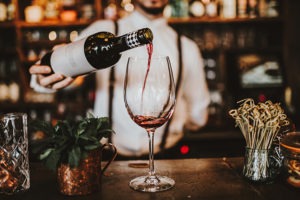
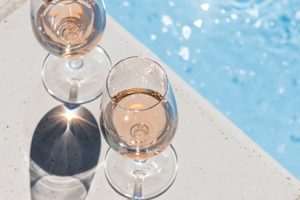
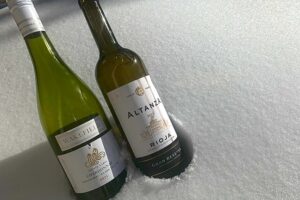
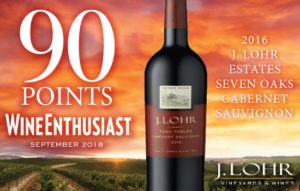
Leave a Reply
Your email is safe with us.